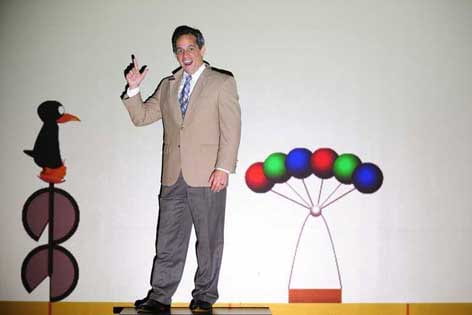A different view of math
Can you learn math without using symbols or language? A four-year, $3 million study led by UC Irvine education professor Michael Martinez will test the theory.

An educational research team will head into Orange County schools this fall to test a different – and possibly better – method of learning math.
Michael Martinez, UC Irvine education professor will use a $3 million grant to lead a study on the benefits of teaching grade-school children – via software – to use spatial temporal reasoning, or visualization, to solve math problems. With computer games, children are able to see math concepts and solutions before trying to understand them through language and symbols. Students in second through fifth grades at 50 low-performing elementary schools will be involved in this largest-ever study of the technique.
“This approach offers the potential for transforming the way mathematics is taught by emphasizing intuitive, visual understanding of concepts and by, at least initially, minimizing technical symbols and terminology,” said Martinez, the study’s lead investigator. “The games are designed to be easy at entry level and then become incrementally more difficult so that the students can gain success and self-confidence, learn to like math and reduce their frustration and self-doubt.”
Instructional software will be supplied by the MIND Research Institute, a Santa Ana-based nonprofit organization dedicated to research on learning and the brain as it applies to K-12 math education. An outgrowth of neuroscience research at UCI, the institute has been developing and testing computer math games since 1999, when it conducted a pilot study of its Spatial Temporal Math program in Los Angeles. ST Math users typically improve their math proficiency level by 10 to 15 points. MIND’s programs reach more than 100,000 students and 4,500 teachers in at least 500 schools across the U.S.
“This unique partnership brings together a large number of schools using cutting-edge, neuroscience-based math software in a consistent, disciplined education process; a skilled, objective study team; and the funding necessary to do a rigorous, credible study of the technique and its results,” said Ted Smith, MIND chairman and CEO. “If determined to be successful, the software and the method have the potential to help millions of underperforming students succeed in math and fill the need for skilled young adults in industry and government. This study will be watched by educators nationwide as they look for a solution to the country’s math education problems.”
Funded by the U.S. Department of Education, this will be the first large-scale evaluation of ST Math programs conducted with strict scientific rigor. Schools were chosen from the state’s lowest-performing 30 percent in math. In each of the 50 schools, either the second- and third-graders or the fourth- and fifth-graders will use the computer games along with regular math lessons. Their progress over four years will be compared with control-group counterparts in other participating schools.
Researchers hope to measure changes in the amount and quality of math learning, as well as differences that might arise based on gender, special needs, variance in spatial temporal abilities, and English-language proficiency. The Orange County Department of Education also is collaborating on the study.
“We are pleased to be involved in this effort to enhance young children’s excitement about, and involvement in, mathematics,” said Stephanie Schneider, the department’s instructional services manager. “The information gained promises to show teachers and schools creative ways to expand involvement in mathematics at an early age.”
Peg Burchinal, education professor, and Lindsey Richland, education assistant professor, at UCI and Fran Antenore and Abby Daniels from MIND also will work on the study.